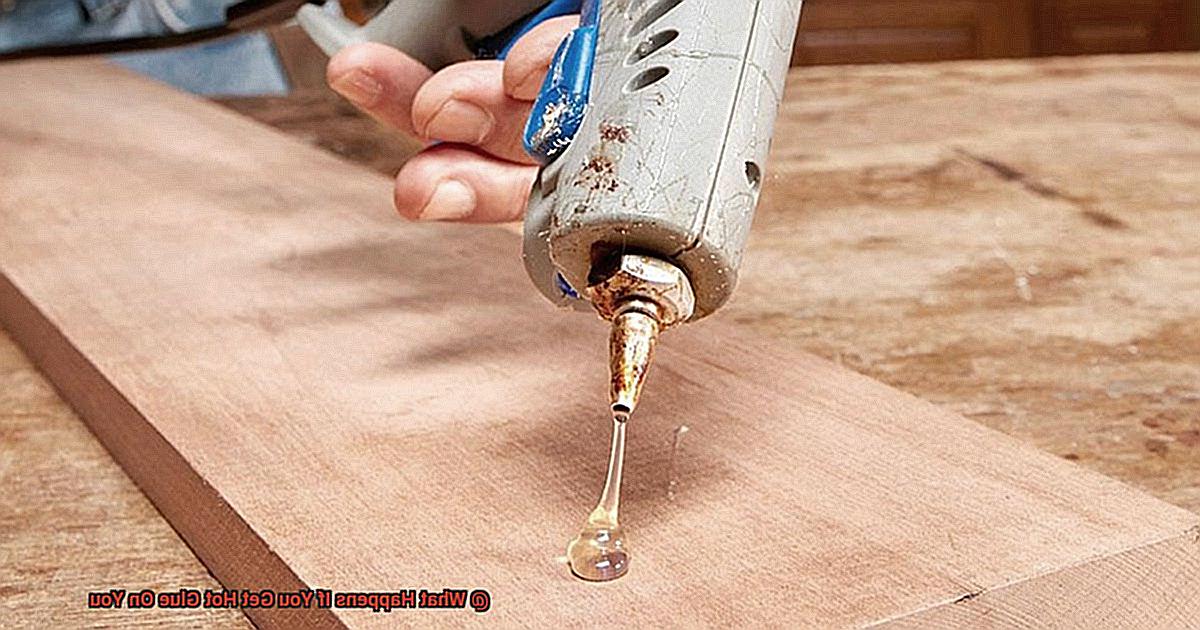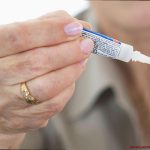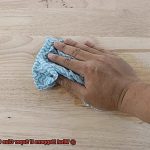Hot glue, our trusty adhesive sidekick for all things crafty and DIY. But what if that sticky stuff accidentally finds its way onto your skin? Cue the panic. While it may not be a life-or-death situation, it’s important to know the potential risks and consequences of this sticky mishap. So, in this blog post, we’ll dive into the effects of hot glue on your skin and give you some essential tips on how to handle the aftermath. Ready to unravel this sticky situation together? Let’s go.
Hot glue may seem harmless, but when it touches your skin, things can get heated (literally.). The high temperature at which hot glue is applied can cause some unpleasant consequences depending on factors like its temperature, contact duration, and your skin sensitivity.
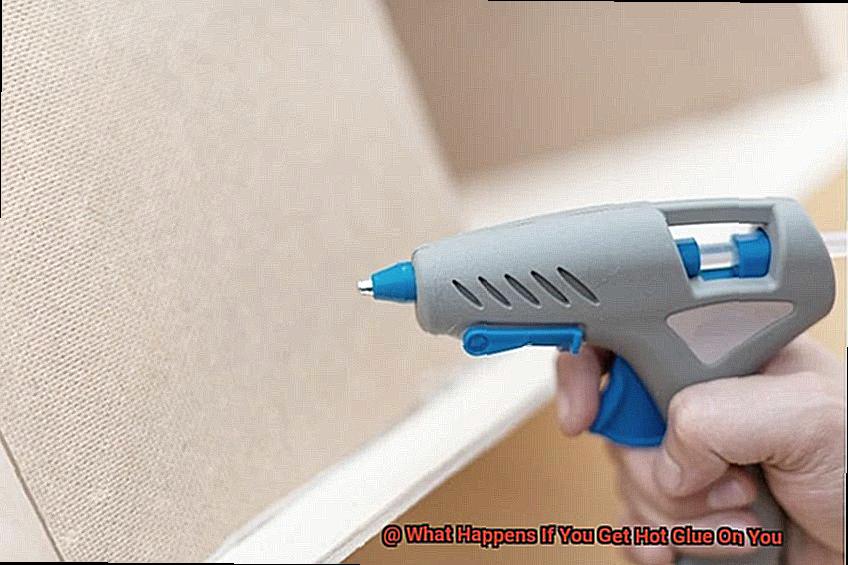
When hot glue meets your skin, you’ll feel an instant ouch. It’ll bring along redness and blistering as unwanted party guests. And let’s not forget about its stickiness – removing it without causing more irritation is no easy feat. That’s why quick action is key to minimizing the effects and avoiding any further complications.
If you find yourself with hot glue on your skin, start by running that area under cold water for a good few minutes. This will help cool down the glue and keep the burn from going full-on inferno mode. Don’t even think about peeling off that stubborn glue forcefully – it’ll only make matters worse. Instead, gently try to loosen any loose bits using a soft cloth or your nimble fingers. But here’s the deal: if that glue is holding tight like superglue on steroids, leave it be. Seek medical advice instead for proper treatment and to dodge any infection bullets.
Now, prevention is always better than a cure (we’ve all heard that one before, right?). So, let’s talk about avoiding hot glue encounters altogether. Wearing gloves is like armor against accidental spills and drips. And if you’re feeling extra cautious, grab some tools like tweezers or pliers to keep those gluey mishaps at bay. Oh, and don’t forget to be mindful of your surroundings and workspace – a little extra vigilance goes a long way in dodging hot glue disasters.
Knowing the risks and consequences of hot glue on your skin is essential for your safety and well-being. By following these tips pronto, you’ll
What is Hot Glue?
Contents

In this captivating guide, we will explore the composition, applications, and safety precautions of hot glue, revealing its remarkable potential.
Composition and Application:
Imagine a world where you can bond anything to everything. That’s the magic of hot glue. Made from thermoplastic polymers, hot glue is transformed into a molten state before application. Its adhesive properties are unrivaled when it comes to bonding materials like wood, fabric, plastic, metal, glass, foam, and ceramics. Let’s dive into its diverse applications:
- Craft Projects: Whether you’re creating handmade cards or crafting intricate art pieces, hot glue is your trusty companion. Its quick-setting feature ensures instant bonding so that your creations stay intact.
- Home Decor: Jazz up your living space with decorative items secured by hot glue. Whether it’s ribbons, flowers, or beads on furniture or picture frames, hot glue’s strong bond will keep your embellishments firmly in place.
- Repairs: Broken objects no longer need to be discarded. With hot glue, you can mend a broken mug handle or reattach loose trim on furniture with ease. Its durable solution saves you time and money.
- Industrial Applications: In industries such as packaging and manufacturing, hot glue plays a vital role. It securely seals cartons and boxes while providing flexibility for handling and transportation.
Safety Precautions:
While hot glue is a creative powerhouse, safety precautions must be taken:
- Avoid Skin Contact: Hot glue can cause burns if it touches the skin. Handle the applicator with caution and wear protective gloves when necessary.
- Cool Water Treatment: If hot glue does come into contact with your skin, immediately run the affected area under cool water. This reduces the temperature and alleviates pain.
- Gentle Removal: After cooling the area, gently peel off any excess glue, taking care not to damage or pull loose skin.
- First Aid Essentials: Keep a well-stocked first aid kit nearby when working with hot glue. Include burn ointment, sterile dressings, and pain-relieving medications.
Risks of Hot Glue Contact with Skin
Hot glue is a versatile adhesive that can work wonders in crafting projects. However, it is crucial to understand the potential risks associated with hot glue contact with the skin. In this blog post, we will delve into the dangers of burns, blistering, allergic reactions, and skin irritations caused by hot glue.
By being aware of these risks and taking necessary precautions, you can protect yourself while enjoying the benefits of hot glue.
Burns: The Heat is On.
Hot glue reaches scorching temperatures that can cause severe burns upon contact with the skin. Handle hot glue guns with care, keeping them away from sensitive areas like your fingers, arms, and face.
Blistering: When Hot Meets Skin
Intense heat from hot glue can lead to blister formation on the skin. Blisters act as protective barriers against further damage, so avoid popping them. Instead, gently clean the area and allow the blister to heal naturally.
Allergic Reactions: Know Your Allergies
Some individuals may have allergies to components present in hot glue, such as latex or other chemicals. If you experience redness, swelling, or itching after contact with hot glue, discontinue use and seek medical advice.
Skin Irritation: No Fun and Games
Prolonged exposure to hot glue can irritate the skin, leading to redness, itching, dryness, and peeling. To minimize irritation risk, take breaks during long crafting sessions involving hot glue and wash hands thoroughly after use.
Safety Tips:
- Use protective gloves or tools like tweezers or wooden sticks while working with hot glue.
- Keep cool water and a first aid kit nearby for quick response to accidents.
- Be cautious and avoid direct contact with hot glue.
Symptoms of Hot Glue Burns
That searing pain on your skin after a close encounter with hot glue is no laughing matter. Hot glue burns are a common injury that can happen to anyone who dabbles in crafts or DIY projects. Whether you’re an amateur artist or a seasoned pro, it’s crucial to familiarize yourself with the symptoms of hot glue burns and how to deal with them.
The first symptom you’ll experience is pain, a burning sensation at the site of contact. It can range from a mild discomfort that lingers like an annoying mosquito bite to an intense agony that makes you want to scream for relief. Trust me, you’re not alone in this fiery battle.
But pain isn’t the only thing you’ll have to endure. Your skin will also turn red and swell up like a balloon, as if the pain wasn’t enough. The once smooth and supple surface of your skin will now resemble a tomato that’s been left on the grill for too long.
In some cases, blisters may form at the burn site, serving as painful reminders of your unfortunate encounter. These blisters can vary in size and may be filled with clear fluid. Remember, as tempting as it may be, resist the urge to pop them. They’re actually there to protect your delicate skin from further harm.
If you thought blisters were bad enough, some burns can cause your skin to peel or become raw. This exposes sensitive nerve endings, leading to increased pain and discomfort. It’s like rubbing salt into an already painful wound, intensifying your suffering.
Once the burn has healed (thank goodness for small mercies.), you might notice some scarring or discoloration of the skin. It’s like a permanent reminder of your epic battle with hot glue—a battle scar for all to see.
In more severe cases, a hot glue burn can lead to infection, which is a whole different level of pain and concern. If you start experiencing increased pain, redness, swelling, pus or discharge from the wound, or even a fever, it’s time to seek medical attention. Infections are not to be taken lightly and require proper treatment.
But wait, there’s more. Hot glue burns can also happen internally if you accidentally swallow hot glue or inhale its fumes. This can lead to difficulty swallowing, chest pain, coughing, or respiratory distress. If you experience any of these symptoms, don’t hesitate—get yourself to the doctor ASAP.
First Aid for Hot Glue Burns
They empower us to create breathtaking masterpieces, mend broken items, and awaken our inner creative genius. But alas, in the midst of crafting fervor, accidents can happen, leaving us with painful hot glue burns. Fear not, my fellow crafters, for I am here to guide you through the essential steps of first aid for these pesky burns.
- Step 1: Swiftly remove the glue. Time is of the essence as leaving the glue on your skin can exacerbate the damage. Gently peel off the adhesive or employ a cool, damp cloth to loosen its grip. Exercise caution, for yanking too hard could worsen the burn and prolong your pain.
- Step 2: Cool it down. Rush to the nearest water source and let its cool embrace flow over the burn for a minimum of 10 minutes. This act of dousing will not only alleviate your agony but also thwart any further harm. If water is not readily available, seize an ice pack or a chilled compress and delicately apply it to the affected area.
- Step 3: Safeguard the burn. Refrain from succumbing to the temptation of popping any blisters that may arise. These fluid-filled shields are nature’s way of safeguarding your delicate skin from infection. Instead, shield the burn with a sterile non-stick dressing or a pristine gauze pad. This protective layer will maintain cleanliness and expedite the healing process.
- Step 4: Tame the pain. Embrace the comfort that over-the-counter pain relievers, such as ibuprofen or acetaminophen, can provide in times of hot glue burn distress. These allies will vanquish your pain and quell inflammation, allowing you to find solace once more.
- Step 5: Seek professional help when necessary. In instances where your burn is severe or covers a substantial portion of your body, it is paramount to seek the expertise of a healthcare professional. These medical virtuosos possess the knowledge and skills to assess your burn accurately and administer appropriate treatment, which may entail prescription medication or specialized wound care.
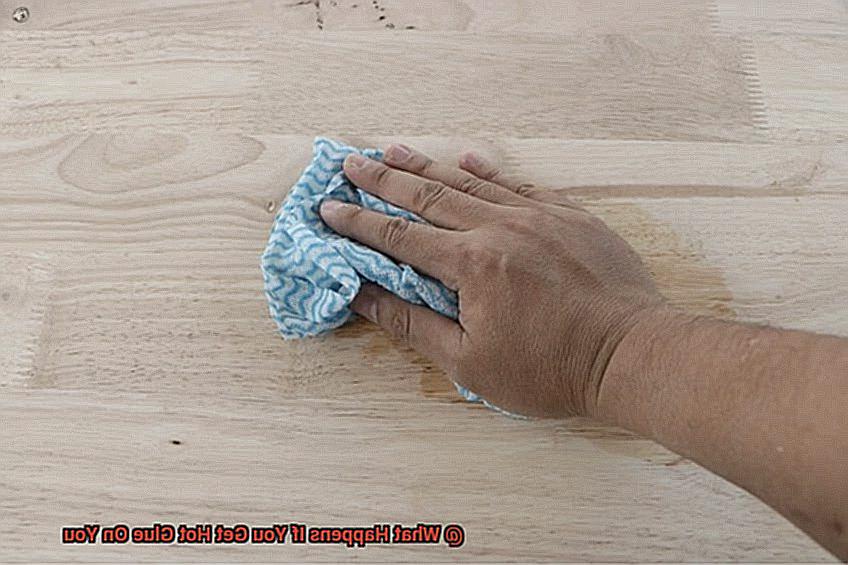
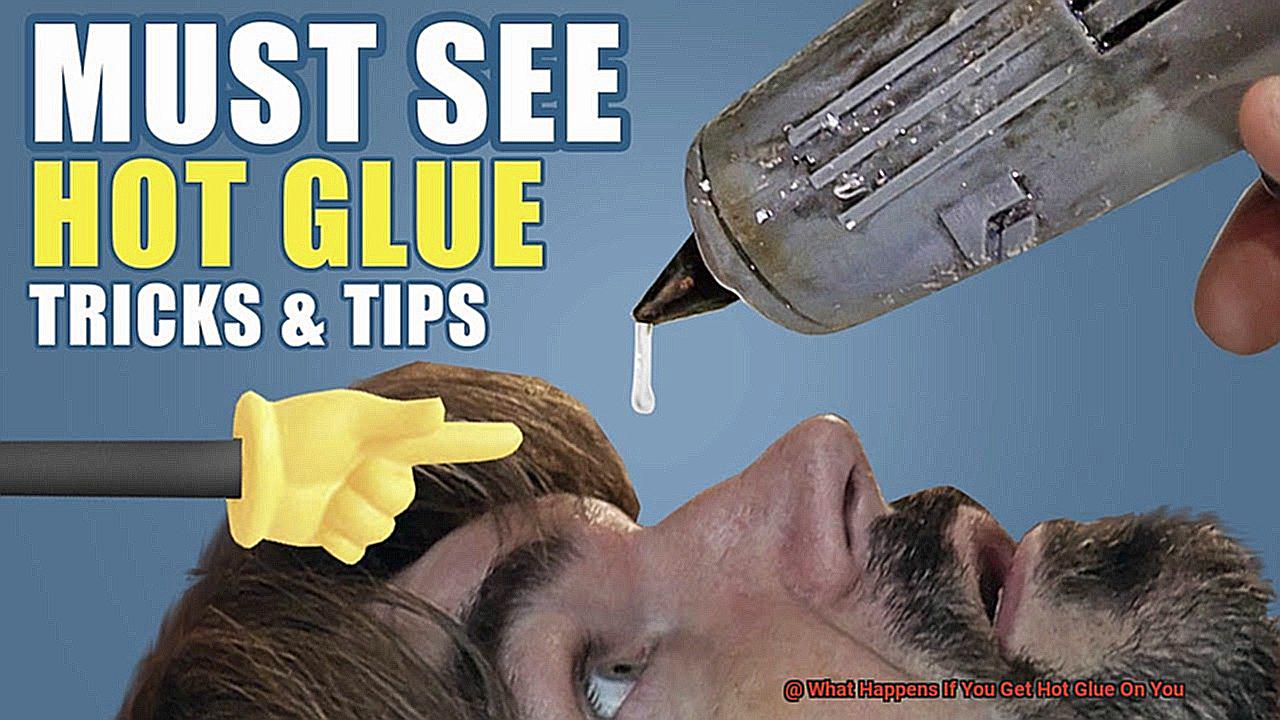
How to Prevent Hot Glue Burns
Hot glue burns can be a real pain, but fear not. By following a few simple steps, you can prevent those pesky burns and enjoy crafting without any worries. In this guide, we’ll explore some easy tips to keep your skin protected while using hot glue. So grab your glue gun and let’s dive in.
Choose the Right Glue Gun:
The first step in preventing hot glue burns is to select a high-quality glue gun with a temperature control setting. This nifty feature allows you to adjust the temperature according to your needs, reducing the risk of burns. Remember to read the manufacturer’s instructions carefully for proper usage and safety precautions.
Protective Clothing is Essential:
Shielding your skin from accidental contact with hot glue is crucial. Wear long sleeves, pants, and gloves to provide an extra layer of protection. Don’t forget about your eyes. Consider wearing safety goggles to safeguard against any splatters or drips that may occur.
Create a Safe Workspace:
Crafting should be fun, not dangerous. Set up a clean and clutter-free work area away from flammable materials. This will ensure a safe environment and reduce the risk of accidents or burns. Keep that creativity flowing without worrying about potential hazards.
Take Breaks:
Remember to give yourself a breather while using the hot glue gun. Prolonged exposure to heat can increase the chances of getting burned. Take regular breaks, stretch those muscles, and keep cool. Your body will thank you.
Keep First Aid Handy:
That’s why it’s important to have a first aid kit nearby. In case of any mishaps or burns, you can quickly treat the injury before seeking medical attention if necessary. It’s always better to be prepared.
When to Seek Medical Attention for Hot Glue Burns
Hot glue burns can range in severity, and it’s crucial to know when to seek medical attention. Minor burns, also known as first-degree burns, typically result in redness, pain, and swelling of the affected area. If the burn is minor and doesn’t cover a large area of the body, you can usually treat it at home. Rinse the affected area with cool water to help alleviate the pain and reduce swelling. Applying a sterile dressing or bandage can also protect the burn from further irritation or infection. Over-the-counter pain relievers can be taken if necessary.
However, if the burn is more severe and covers a larger area of the body, it’s time to seek medical attention. Second-degree burns involve damage to both the outer layer of skin (epidermis) and the underlying layer (dermis). These burns can cause blisters, intense pain, and potential infection. In these cases, it’s important to visit a healthcare professional who can assess the burn and provide appropriate treatment. They may clean the wound thoroughly, apply specialized dressings or ointments, and prescribe pain medication or antibiotics if needed.
In addition to burn severity, signs of infection should not be ignored. Increased redness, swelling, pus formation, or fever are all indicators that an infection may be present. Infections can complicate the healing process and may require more aggressive treatment. If any of these signs are present, seeking medical attention promptly is crucial.
Certain individuals may be more susceptible to complications from hot glue burns. This includes individuals with pre-existing medical conditions such as diabetes or compromised immune systems. In these cases, seeking medical attention promptly is crucial to prevent further complications.
Treating Severe Hot Glue Burns
Hot glue burns can cause significant pain and potential complications. Whether you are a DIY enthusiast or a professional crafter, accidents can happen. Knowing how to treat severe hot glue burns is essential for a speedy recovery and minimizing the risk of infection. In this article, we will outline the necessary steps to take when faced with a severe hot glue burn.
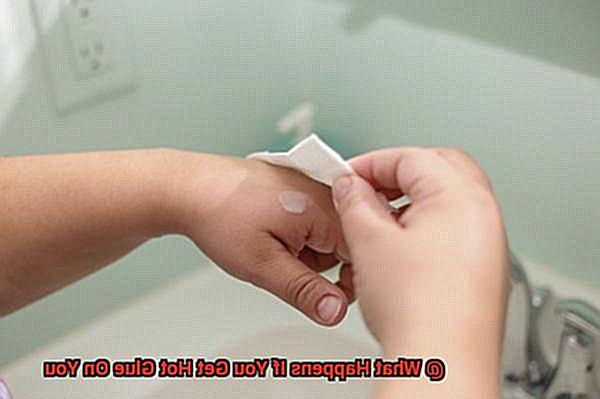
Step 1: Remove the heat source:
Immediately remove the source of heat by gently wiping away any liquid hot glue with a cool, damp cloth. Avoid pulling or peeling the hot glue off the skin to prevent further damage and reduce the risk of infection.
Step 2: Cool down the burn:
Quickly cool down the affected area by running cool water over the burn for at least 10 minutes. This helps dissipate the heat and provides relief from pain. Never apply ice directly to the burn as it can cause additional tissue damage.
Step 3: Protect and dress the burn:
Apply a sterile, non-stick dressing to protect the burn and promote healing. Avoid using adhesive bandages or tape directly on the burn as they can stick to the skin and cause more pain when removed.
Step 4: Manage pain and inflammation:
To manage pain associated with severe hot glue burns, consider over-the-counter pain relievers like acetaminophen or ibuprofen. Follow recommended dosage instructions and consult a healthcare professional if you have concerns.
Step 5: Seek medical attention if necessary:
If the burn is severe or covers a large area of the body, seek medical attention. A healthcare professional can assess the extent of the burn and provide appropriate treatment, such as specialized dressings or medications to prevent infection.
Step 6: Monitor for signs of infection:
Keep the burn clean and dry during the healing process. Watch for signs of infection like increased pain, redness, swelling, or pus. If these symptoms occur, seek medical attention immediately.
Step 7: Patience and care in the recovery process:
Depending on the severity of the burn, it may take several weeks or even months for the skin to fully heal. Be patient and follow your healthcare professional’s instructions for proper wound care. Avoid exposing the burn to excessive moisture and refrain from using creams or ointments not recommended by a healthcare professional.
Tips for Working with Hot Glue Safely
Hot glue is a versatile adhesive that can be used for various crafting projects. However, it can also pose risks if not handled safely. In this article, we will explore some essential tips to help you work with hot glue in a safe manner, minimizing the risk of burns and other injuries. Let’s dive in and learn how to craft with confidence.
Shield Yourself with Protective Gear:
When working with hot glue, it is crucial to protect yourself from potential burns and skin damage. Always wear heat-resistant gloves to shield your hands from accidental contact with the hot glue. Additionally, consider wearing safety goggles to protect your eyes from any splattering or flying glue.
Use a Heat-Resistant Work Surface:
To prevent accidental damage to your workspace and reduce the risk of burns, use a heat-resistant mat or silicone pad as your work surface. These materials act as a protective barrier between the hot glue and your table, ensuring both safety and preserving the integrity of your work area.
Stay Cool with Cold Water:
Accidents happen, but you can quickly minimize the damage by keeping a bowl of cold water nearby when working with hot glue. If hot glue touches your skin, immediately immerse the affected area in the cold water for several minutes. This simple action will cool down the glue and reduce the extent of burns.
Watch Out for Drips:
Hot glue can sometimes drip from the nozzle while you’re working on your project. To avoid accidental contact with these hot drips, keep your fingers away from the nozzle area when not in use and stay vigilant. Be aware of any potential drips and take necessary precautions to prevent accidental burns.
Take Breaks to Prevent Overheating:
Crafting sessions can be exciting and time-consuming, but it is important to take regular breaks to allow your glue gun to cool down. Overheating can increase the risk of accidental burns. By taking breaks, you give your glue gun a chance to cool down, ensuring a safer working environment.
Also Read: Is Hot Glue Toxic? – Glue Things
Conclusion
When hot glue comes into contact with your skin, it can cause immediate pain and discomfort. The heat from the glue can cause burns, similar to a mild thermal burn. Depending on the temperature of the glue and the duration of contact, you may experience redness, swelling, and blistering in the affected area.
It’s important to act quickly if you get hot glue on your skin. Start by rinsing the area with cool water to help cool down the glue and alleviate some of the pain. Avoid using ice or very cold water, as this can further damage the skin. Gently patting the area dry with a clean towel is recommended.
If you notice any blisters forming or if the pain persists after rinsing, it’s best to seek medical attention. A healthcare professional can assess the severity of the burn and provide appropriate treatment. They may recommend applying an over-the-counter burn ointment or cream to soothe the affected area and promote healing.
While waiting for medical assistance or if you have a minor burn, you can take steps to minimize discomfort. Applying aloe vera gel or a cold compress wrapped in a soft cloth can help soothe the burn and reduce inflammation. Over-the-counter pain relievers like acetaminophen or ibuprofen can also provide temporary relief.
Remember, prevention is key when working with hot glue. Wearing protective gloves and long sleeves can help minimize direct contact with your skin. Additionally, being mindful of where you place your hands while working with hot glue can prevent accidental spills or splatters.
In conclusion, getting hot glue on your skin can result in painful burns. Acting quickly by rinsing with cool water and seeking medical attention if necessary is crucial for proper care. Remember to take preventative measures when working with hot glue to avoid these unfortunate accidents altogether.

